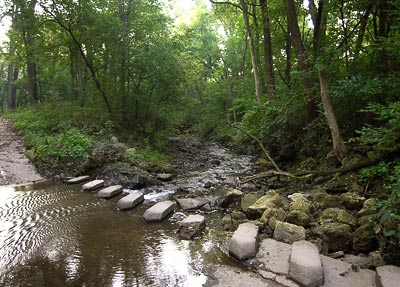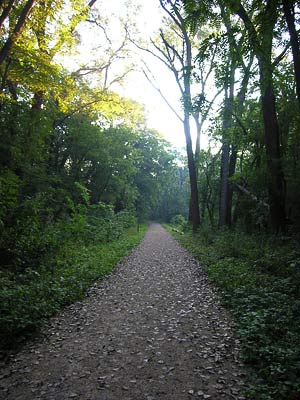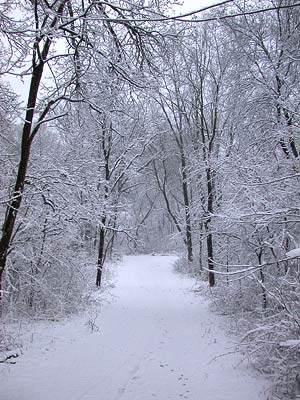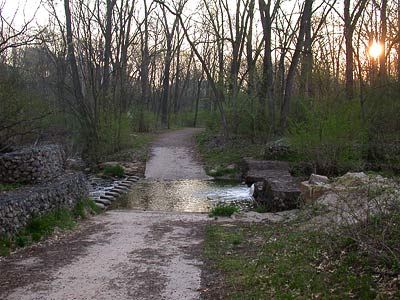
One of several such stepping-stone stream crossings.
Time and a little understanding have eased my vitriolic and emotional attitude toward Middleton's Public Lands practices and what some are calling “aggressive improvements” regarding restoration efforts at Pheasant Branch Conservancy. I've locked horns with Middleton Common Council and Penni Klein (Middleton's fervid public lands manager) in the past because I haven't agreed with certain park-like "beautification" and access projects. For the most part, though, I don't believe the current preventative erosion and restoration work along the stream corridor will adversely affect the birds that use it during migration or breeding season. Given time, I suspect some of the changes may even turn out to be beneficial for birds.

The Corridor Trail
Recently there have been op-ed pieces in the Middleton Times Tribune concerning these particular restoration efforts, but since the Tribune doesn't seem to be on-line, I'll cite a few pertinent quotations. Todd Berry of Middleton has his heart in the right place, but I doubt there is anyone who visits the stream corridor as frequently or spends as much time exploring it as I do, and I will differ with his opinion on the bridges. This may come as a surprise, but I agree with the city of Middleton as to why bridges need to be placed at the stream crossings. I'm not only watching birds while I'm there, but what people are doing, too. I'll have more on the latter in a moment.
As far as birds go, my eBird entries indicate that since January 1st of this year, I've birded Pheasant Branch Conservancy over 90 times in 2007. Of course, back-to-back days are more frequent during spring and fall migration. I try to at least get into the corridor once a week during the winter months. Since I have a good idea which bird species nest along the corridor, I often decrease my visits there in the summer and spend more time observing and photographing critters at the prairie and savannah on the north end of the conservancy.

Corridor Trail in Winter
Though the master checklist for the conservancy is up to 210 bird species, eBird indicates 175 species for the year 2007 (though that will undoubtedly increase this fall when ducks return). Naturally, there are birds on the master list inconsistently observed year-to-year, such as Peregrine Falcon, Hooded Warbler, White-eyed Vireo, Long-eared Owl, Varied Thrush, Harris's Sparrow, Pileated Woodpecker and many others. Depending on weather and water levels, mudflats occasionally form on the marsh, attracting a variety of shorebird species not typically observed at the conservancy. A birder I know photographed Willets at one of the ponds - a new species for Pheasant Branch in 2007. Looking at June and July for breeding candidates, 72 bird species were present in 2007 on conservancy lands (all sections, stream corridor, prairie and savannah). One section I don't yet have good records for is the marsh because there is no trail access; however, I suspect Sora, Virginia Rail, Marsh Wren and other associating species are probably present each year. They've been recorded in past years by myself and others, some who have canoed the stream bisecting the marsh.
Yesterday while birding with Sylvia and Dottie along the stream corridor, we saw a completed counter-measure erosion project along one bank, which I believe is the first of three such efforts under the current plan. Initially, it was quite shocking to see an area cleared away of large dead trees, many living smaller trees and brush where the stream makes two abrupt turns. But it was obvious in watching the sandy bank recede over the past several years that Penni would eventually be obligated to do something to curb erosion before it got too close to the adjacent apartment buildings beyond the line of trees at the top of the ravine.
On October 2nd, Todd Berry wrote to Middleton Times Tribune:
"We have large and expensive bridges where simple stepping-stones and shallow crossing served us well for decades. We have destruction and repaving of a park path that needed no replacement – only it now covers more area that was once vegetation."

Another crossing during Spring.
Let's talk about those stepping-stones (pictured above). After a heavy rain, the otherwise serene, trickling stream transforms into a raging rapids, capable of carrying entire trees down the corridor - I've seen it. The water level has risen as much as 2 feet or more during such conditions. The concrete crossings are impossible to get across because the stepping-stones are completely submerged under the rushing water. Some may contend that development on the west side of Middleton, over part of the Pheasant Branch watershed, is a contributing factor as to why the water levels rise so quickly during and after storms. But, I have to say that I've seen the corridor flood this same way after storms over a decade ago when the west development was significantly less intense than what it presently is today.
You would have to be a fool to try and cross the stream when it's flooded after a storm. You're likely to lose your life – it's impossible to cross without bridges under such conditions. For better or worse, the corridor trail is now a popular and safe artery (from automobile traffic) for joggers, walkers and bicyclers to get from one side of Middleton to the other. This past spring and summer, I rode my bike on the trail many times as part of my commute to work. I take the trail from Pheasant Branch Road to the business park where Eagle Optics is located, which accounts for 5 of the 11.5 miles of my commute from Waunakee. When the stream is flooded, the trail is simply impassible. When birding, I can't get to all the sections of the corridor I typically like to visit.
For several years, there's a certain jogger I see along the stream corridor who occasionally stops and asks about birds I'm seeing. This past spring he told me he had fallen into the stream after slipping on the stones because they were covered with black ice. Without bridges, and with more people using the trail, it's only a matter of time before someone is seriously injured or possibly killed. Trees fall during storms and sometimes block the path. To get to them, the bridges need to be strong and wide enough for service vehicles to cross. In the context of a multi-use trail, the bridges are necessary. Just a week ago I observed a man in an electric wheelchair struggle to get across the stream. He briefly got stuck right in the middle of the water, but eventually managed to get himself across. This time the water level was low enough not to deter him, but after a storm, forget it. When the man got over to our little birding group, he asked what we were looking at. We pointed out Tennessee, Black-throated Green and a few other warblers to him. These were probably the first warblers he's ever seen. You know, I like the stepping-stones, too. I think they're quaint, scenic and fun to cross. But shouldn't everybody be able to enjoy the conservancy without having to worry about the inherent dangers of crossing the stream?

I'll doubt you'll find a more passionate advocate for the birds of Pheasant Branch Conservancy than me. The vegetation along the corridor trail includes multitudes of exotic invasive plant species that are proliferating downstream. Of course, mowing along the trail can assist in spreading them, too. I'm all for their diligent and systematic removal provided that similar habitat structure is retained with native plants for birds that favor the habitat structure appearing a particular way. If the structure is radically modified, it's inevitable some bird species will decrease while others potentially increase relative to the form and composition of the habitat. Year-round residents like the Carolina Wren, Tufted Titmouse and Red-bellied woodpeckers depend on decaying and rotting trees for insect larvae - removing them makes it just a little harder for them to find food. As our winters in southern Wisconsin continue to be milder, I observe more and more American Robins and Hermit Thrushes in December through February subsisting on buckthorn berries at the conservancy. Yes - remove the buckthorn, but replace it with native berry trees. Apparently, this is part of Penni's plan.
Former Middleton Mayor, Doug Zwank, replied to Berry's op-ed saying:
"Contrary to Mr. Berry's opinion, our public lands are in much better shape today than they were 10 years ago. In fact, every year they continue to improve. This is supported by the many awards and recognition of successful projects by conservation groups."
Perhaps so, Mr. Zwank. Middleton recently received prestigious recognition by Money Magazine for being the best place to live in America. Cited in this somewhat dubious distinction was credit for Middleton's fabulous public parks. They are spectacular and that's why I bird and photograph there. My gauge won't consist of such illustrious awards and praise to measure the quality of Pheasant Branch Conservancy. Instead, it will be done so by the number and diversity of bird species I observe using the conservancy's various habitats as stop-over points during spring and fall migration, and also by the species that breed and successfully fledge young there. Improve that, and you'll earn my praise (not that it will matter to Middleton). My finger is firmly pressed on the record button; every bird I see or hear there is being counted in eBird. So, we'll eventually see if Middleton has done right by the birds.
All images © 2007 Mike McDowell

















